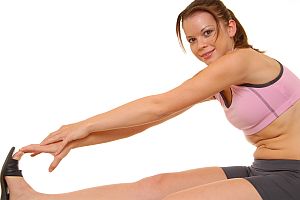4 Effective Means to Alleviate a “Charley Horse”
 You’re lying in bed and just about to go to sleep and then all of a sudden, you feel that pull start deep in your calf muscle. You know exactly what is coming; the seizing pain of another “Charley Horse” sets in.
You’re lying in bed and just about to go to sleep and then all of a sudden, you feel that pull start deep in your calf muscle. You know exactly what is coming; the seizing pain of another “Charley Horse” sets in.
“Charley Horse” is a slang term for a painful muscle spasm that can happen in any muscle but most often it happens in the calf or foot. Sometimes you may experience this pain in the arms, hands, rib cage, abdomen, or thighs. It is characterized by a tight or “seizing” sensation. The pain can last for just a few seconds or stretch out over a period of days. The affected area can become difficult to touch.
Just about everyone will experience this common type of muscle spasm from time to time. Sometimes the worst part is just the fear of when it’s going to happen again.
The important thing to know is that you can prevent this pain from coming and even from hitting its peak when you feel it starting. Knowing how to alleviate a Charley Horse effectively will be profoundly helpful to you when you are trying to rest and just feel better.
Common Causes and Prevention
Charley horses are commonly caused by exercising without stretching first. Dehydration, hormonal imbalances, dietary deficiencies, nerve malfunction, and reactions to medication can all contribute to creating a painful charley horse episode. Here’s what you need to know:
- Encourage and maintain flexibility. Stretching exercises are highly useful for both alleviating and preventing the dreaded charley horse. If a muscle spasm affects your calf or the back of your thigh, you can stretch it out by lunging forward, putting your weight on the affected leg, and slightly bending your knee. If a cramp or spasm is affecting the front of your leg, you can alleviate it by using a chair to balance while pulling your foot up behind you, toward your bottom.
- Massage the affected area. Massaging the affected area can release and relieve muscle tension, allowing the spasm to subside. Applying hot and cold compresses can also assist in alleviating the pain. You can also elevate the affected area to increase blood circulation and encourage the release of tension.
- Drink plenty of water. Dehydration is a leading cause of charley horses. Water keeps your muscles hydrated and truly “fluid”. You can alleviate and prevent them by drinking lots of water.
- Eat More of the Right Foods. A low sodium diet combined with increasing your consumption of potassium-, magnesium-, and calcium-rich foods is recommended. Foods to eat include bananas, oranges, avocados, almonds, halibut, spinach, kale, and dairy products. Vitamin supplements can also assist in increasing your potassium, magnesium, and calcium levels. Lastly, avoid diuretics (i.e. caffeine or drugs) as they can deplete your hydration and electrolytes.
What about if you need help now? They just keep coming back!
If you’re experiencing charley horses on a frequent basis, they could be an indication of a physical problem. For example, a pinched nerve can cause reoccurring muscle spasms and is correctable via chiropractic adjustment. Also body imbalance can cause frequent muscle spasms such as Charley Horses. Imbalance of your posture is where your muscles are pulling stronger on one side of your body in comparison to the other side or pulling on one side of a body part- such as your leg- versus the other. This causes a muscle to experience more episodes of spasm than if it was balanced. Consult us today for a comprehensive diagnosis to see if you have the tell-tale signs of faulty foot, ankle or hip muscle movement patterns or other health disturbances that may cause Charley Horses.